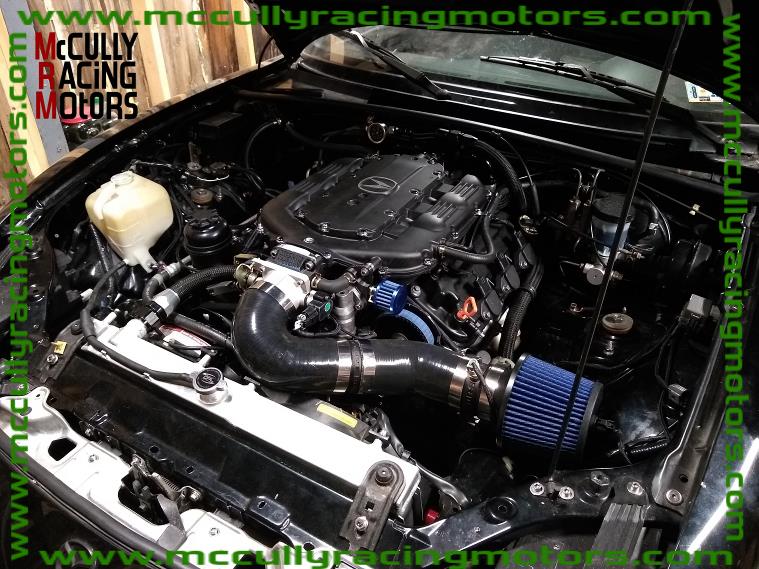

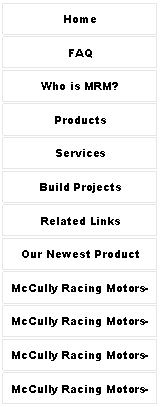
|
Our third build receiving its new heart. |
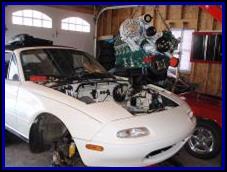
|
FAQ |
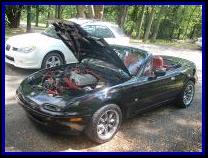
|
We built this LE MRM 306 conversion over the summer of 2008. A year later it received a set of AFR heads and an an Edelbrock intake and now makes 280 rwhp! |

|
Home |
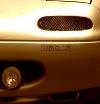
|
Products |

|
Builds |

|
Who is MRM? |

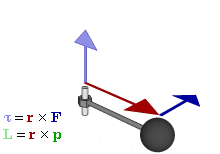


McCully Racing Motors |
|
Because two heads are ALWAYS better than one. |
|
Blog |
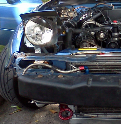
|
FAQ |

|
Links |

|
Video Links |

|
Random Pics |

|
TFI Specific: Question: You seem to be into Miatas. Why did you develop a kit to alleviate a problem that only Fords have?
Answer: The Miatas you see on these pages are not “normal” Miatas. They have all been converted to Ford V8 “Monster” Miatas. Most Ford V8 Miatas use the Ford TFI ignition system as found in a 1987-1995 Mustang. The tight confines under a Miata’s hood only intensifies the hot conditions that kill TFI modules in OEM Fords. When I first became involved in the Miata engine swap community it was accepted practice to just carry an extra TFI module in your glove box and change it out twice a year. I found this to be unacceptable for a car I wanted to drive every day. I developed the kit first to solve my own problem and then started selling them to others with V8 Miatas. Eventually I started providing them to Ford TFI owners the world over and honestly can not believe how popular they have been!
Question: What is the purpose of the wire with the eyelet on it? Is it a ground? Should I attach it to the negative battery terminal?
Answer: I wrap my Mk2 signal jumper harnesses and Mk3 combo harnesses in Electro Magnetic blocking foil tape in order to encapsulate them in a “Faraday Cage” which drains built up environmental current through the eyelet you are referring to. This prevents electro magnetic impulses from other engine bay and natural/man made sources from setting up a resonance wave in the length of wire that would interfere with the micro voltage signal the TFI uses to time the ignition. For that reason the eyelet should be connected to the FRAME of the car, not the negative battery post. The idea is to give it a large metal structure to dissipate the undesired signal into (the frame of the car) rather than let it interfere with your timing signal.
Non TFI: Question: What is in the future for MRM? You seem to be moving from Ford based projects?
Answer: I think its important to recognize and accept the changing nature of the universe. In the larger sense that refers to everything around us, in the case of this business it refers to the use of engines which are becoming less prevalent. The Ford Winsor is a legendary engine platform that served in everything from a delivery van to a GT40. That said, the developments in engine design in the last 50 years have been revolutionary. Ford’s own Coyote 5.0 is a fine example of this. In the same sense Ford’s OBD1 fuel injection system is a marvel of simplistic yet reliable programming and technology that is amazing to think was developed in the 1970’s. It too though has been eclipsed by more modern aftermarket and OEM systems. Long story short, I think that, although enthusiasts of 1980’s fuel injection systems will exist, the market for what I make here is sure to dry up at some point. Even with my own Miata conversions I’ve moved from the Ford swap to the up and coming Honda J32 swap. The latest build I’ve done, which will hopefully be featured more prominently on the next update of this site, utilizes over ten different 3d printed parts that without which the build would not have been possible. These parts include the throttle body adapter, IAC valve block, Vacuum block, intake hose couplers and others. My hope is to start offering those parts for sale here after proving their ability to hold up in my own car. Stay tuned, hopefully some new products will be coming up on the horizon. |
